[ad_1]
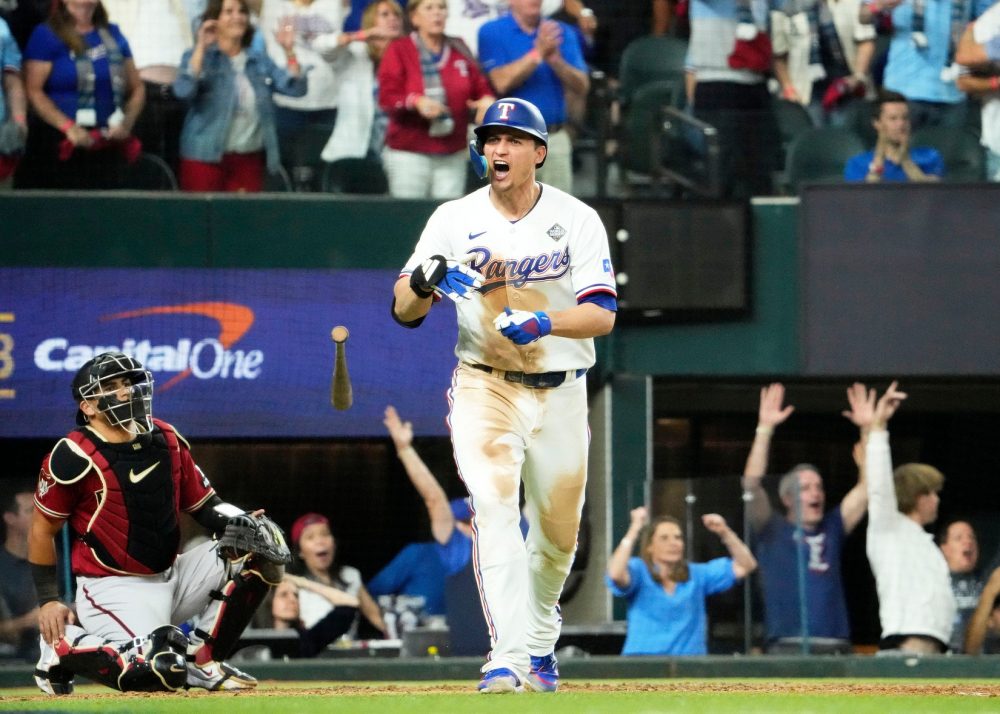
Picture credit score: Rob Schumacher-Arizona Republic
This text was originally published on November 8, 2023.
The Rangers are celebrating their first World Sequence championship in franchise historical past for various causes. Due to clutch showings from Nate Eovaldi and Jordan Montgomery all postseason lengthy. Due to well-timed scorching streaks from seemingly the one two dependable arms in an in any other case shaky bullpen in Jose Leclerc and Josh Sborz. Due to clutch performances in lengthy reduction from Jon Gray; the listing goes on and on. Each champion has such an inventory. However there could be no doubting the driving pressure behind this Texas title: Their extremely deep and productive lineup, one which had no holes from leadoff hitter Marcus Semien to ninth hitter Leody Taveras.
The lineup that stole probably the most headlines through the common season performed at Truist Park in Atlanta, and it was pretty simple to level to what the Braves did effectively: 307 residence runs speaks for itself. Whereas Texas definitely options hitters able to unimaginable energy—Corey Seager, Adolis Garcia, Mitch Garver, and Ezequiel Duran had been all within the prime 20% of the league’s hitters in ninetieth percentile exit velocity, with Nathaniel Lowe not a lot additional behind—their lineup was in a position to grind away pitchers with greater than brute power. The lesson we will be taught from this 12 months’s champs is that when placing collectively a World Sequence-winning lineup, it helps when almost each hitter on the roster possesses a sophisticated understanding of the zone, the rely, and find out how to leverage these two issues collectively to get pitches they may do harm on.
The interplay of these expertise materialize in typically troublesome to trace methods utilizing public metrics. A typical evaluation of a hitter’s plate self-discipline would start with their chase price—or O-Swing share—which measures how usually they increase the zone, aka swinging at pitches they shouldn’t. It’s probably the most generally referenced metric for analyzing a hitter’s method; Juan Soto leads the league on this space 12 months after 12 months whereas Javier Baez charges among the many worst, as one may count on. The Rangers, relying on which web site you’re utilizing, typically rated as one of the vital disciplined groups by chase price within the league. They had been fourth-best by PitchInfo, sixth by Statcast, and fifth based on Sports activities Data Options (every web site defines the boundaries of the strike zone in their very own approach, which results in the variations between these metrics quantifying the identical factor).
Chase share, for all its deserves, doesn’t inform the entire story. Regardless of a seemingly intuitive relationship with high quality of contact—pitches farther from the zone are tougher to place good wooden on—it doesn’t have a lot of a statistical relationship with any of the extra ubiquitous energy measures. For instance, with remoted slugging (ISO)—the distinction between a participant’s slugging share and batting common, successfully representing a participant’s “additional base hits” talent—chase price has a reasonably weak correlation (r of -.105 for 2020-2023). As a substitute, it has a a lot stronger relationship with a participant’s stroll price (r of -.79 with BB%). It’s not measuring a hitter’s means to acknowledge pitches they will hit, however as an alternative it quantifies a participant’s information of the zone. The talents are associated, however not the identical.
Take Corey Seager—now a two-time World Sequence MVP, Seager has arguably the purest approach in the game for a hitter. That’s mirrored not by his chase price—that’s just about league common—however by his aggression on pitches within the zone relative to that chase price. Seager is routinely among the many league leaders in zone swing (Z-Swing) price minus chase price (O-Swing)—in any other case generally known as Z-O Swing.
Whereas Seager’s Z-O Swing ratio clearly quantifies some distinctive talent that he seems to own, the addition of zone swing price solely bumps the correlation to ISO to a .253 r. The advance does trace at how we needs to be eager about swing selections, although. The essential factor concerning the pitches that Seager swings at isn’t that they’re strikes. It’s that they’re hittable, no matter balls and strikes, due to their location. Letting a hittable pitch land within the zone usually results in worse outcomes down the street for a hitter. The important thing a part of making any resolution is weighing up the advantages of an motion vs. the price of inaction. For Seager, that equation is easy: if he’s in a position to drive it then he hits it, and if he can’t then he doesn’t. He’s not ready for a selected pitch that will by no means come, however simply the primary one which he can harm. In that approach he by no means cedes management of his at-bats to the pitcher. Pitchers can cover their fastballs from hitters who hunt them, however they will’t keep out of the zone altogether in the event that they need to keep within the sport very lengthy.
With that in thoughts, I needed to measure the cost-benefit of every attainable resolution a hitter could make in a approach that might be extra statistically related than Z-O Swing. The fast and soiled of that course of: I checked out each pitch since 2020 and located the common run worth of a swing and a take at every mixture of rely and placement across the plate. I weighted every of these values by the likelihood of a known as strike, in order that the perimeters of the zone would replicate the 50/50 nature of these calls, then I discovered the distinction between the 2 to point out the full “worth” that was up for grabs. Damaged out by swings and takes, that appears like this:
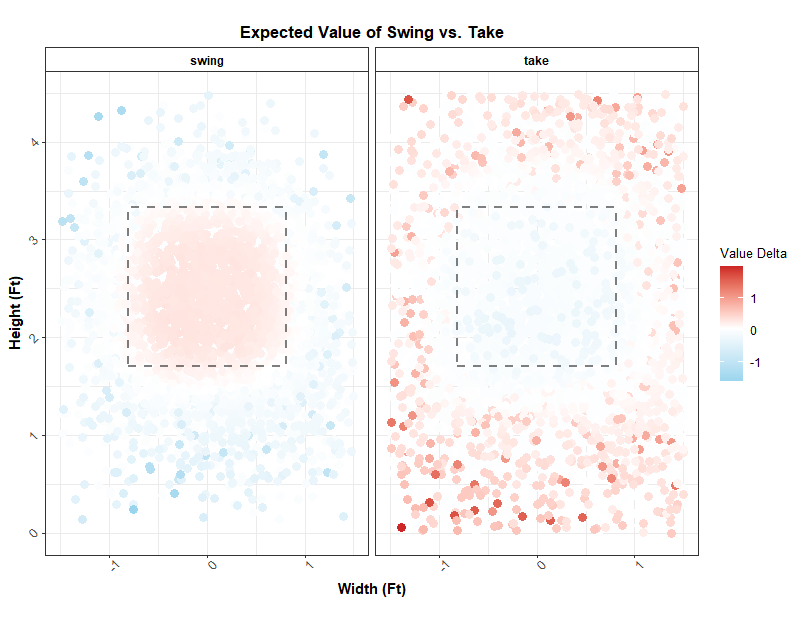
simply swings, we get this once we additional separate into the counts through which the pitch was thrown:
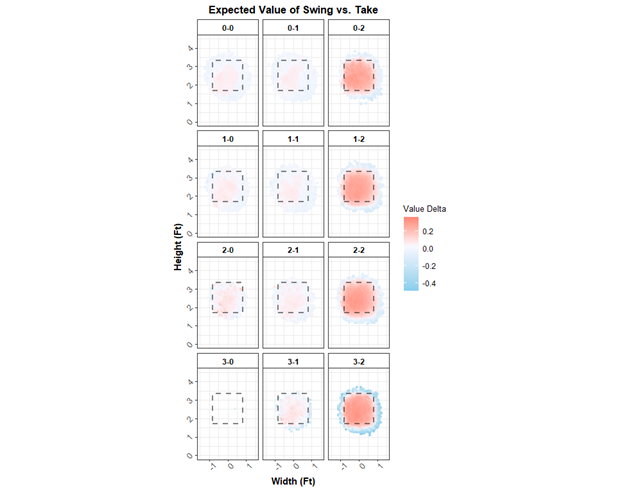
What this exhibits is that with two strikes, a hitter ought to at all times swing at something with a fairly excessive probability of being known as a strike, which makes intuitive sense. It additionally penalizes gamers with rising severity for swinging exterior the zone after they’re about to be gifted a stroll, and rewards gamers for swinging at pitches within the coronary heart of the zone in almost any rely. Importantly, the penalty for being overly aggressive early in an at-bat is considerably smaller than it’s later in an at-bat, incentivizing early swings—inside cause—until a hitter can confidently deal with a two-strike rely.
Utilizing these deltas between the common values of a swing and a take, we will succinctly grade a participant’s swing selections by whether or not they added or subtracted to their anticipated worth on every pitch.
Following the identical logic as Z-Swing minus O-Swing evaluating good decisions to unhealthy ones, we’ll look first at an space through which Corey Seager shines: not letting these hittable, high-value pitches by him. For our functions, meaning what number of of a participant’s taken pitches had been constructive anticipated values, aka “hittable.” A decrease share is healthier right here, for the reason that concept is that deciding not to swing is popping down an opportunity to do harm. Amongst gamers with 200+ PA in 2023, listed below are the leaders (left, in blue) and laggards (proper, in orange) in Hittable Pitches Taken (as a share of whole takes):
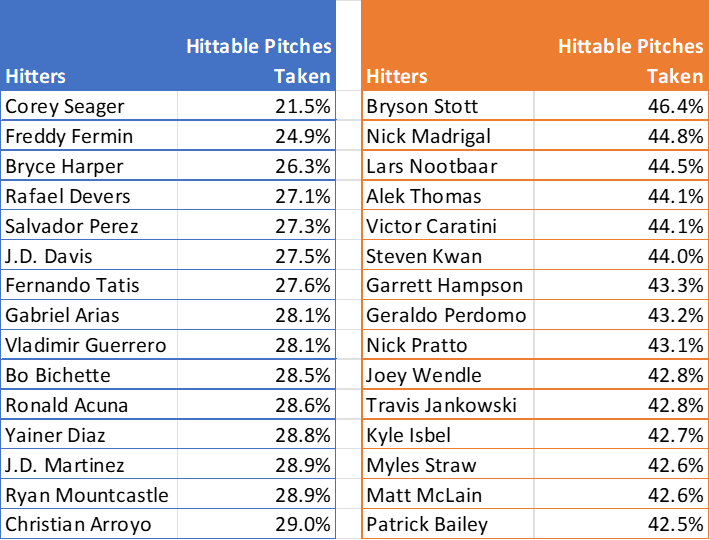
Shock! Corey Seager sits atop the measure he impressed, letting fewer favorable pitches go unpunished than some other hitter. If it looks like a number of the different names on both aspect are seemingly misplaced for a plate expertise leaderboard, keep in mind that this isn’t monitoring balls and strikes judgment: It’s how opportunistic every hitter is. Mainly, this measures aggression when the hitter sees one thing they will do harm on.
On the opposite aspect of the spectrum, the hitters on the appropriate had been typically deemed too forgiving in direction of pitchers—almost half the pitches Bryson Stott took had been doubtlessly hittable, which is smart when you concentrate on his acknowledged plan of laying off high fastballs in 2023 and his consolation stage hitting with two strikes. That method principally labored out okay for him, however the implication right here is that he’s leaving harm on the desk by being overly passive.
If that measures aggression, now we’d like a proxy for choice. For that we’ll take a look at how most of the good selections a hitter makes that had been the results of not swinging at unhealthy pitches. That is their functionality or tendency in direction of being selective. A better quantity is healthier right here; a low whole can point out unhealthy pitch recognition or a reckless method. Evaluate the leaders and laggards to see what I imply:
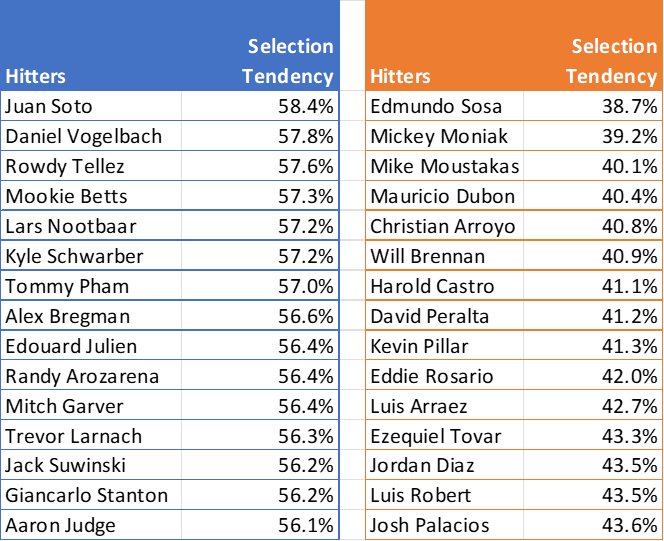
The hitters on the left are a number of the choosiest within the sport, and in addition a number of the names we most affiliate with endurance. A lot of the gamers on the appropriate could be safely categorized as “free-swinging.”
The ultimate step is evaluating our two numbers. The distinction between these ratios provides us a “Z-O Swing-like” determine that represents how effectively a hitter balances opportunism with warning. Since he’s the patron saint of selective aggression (and since this produces a unit-less quantity that’s laborious to explain), we’ll name this SEAGER: for SElective AGgression Engagement Charge. That leaderboard appears like this:
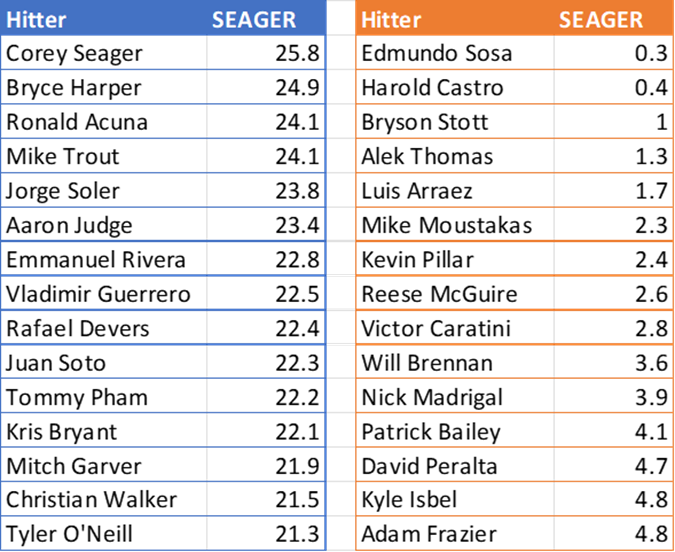
This new metric provides us an appraisal of how effectively a hitter stays on the entrance foot whereas retaining sufficient self-discipline to navigate the rely and finally settle for free passes to first base. It’s a little bit of an inelegant statistic as a result of—like Z-O Swing—it’s an interplay of ratios with totally different denominators, nevertheless it nonetheless bears a stronger relationship with key offensive statistics than each Z-O and chase price have in each the current and in future seasons:

With out factoring in a hitter’s distinctive energy potential in any approach—something I’ve tried to do earlier than, unsuccessfully—we’ve reached a weighted correlation of .41 with subsequent season ISO based mostly solely on a hitter’s swing selections. That’s fairly good! SEAGER is considerably much less dependable—which means correlated with itself—than each of the alternate options (undoubtedly a downside), however higher explains energy manufacturing within the brief and long run, which was the last word aim right here. Mission completed.
Let’s do a fast recap earlier than we go:
- Plate self-discipline is extra than simply drawing walks
- What you swing at—hittable pitches—is extra essential than what you don’t—balls exterior the zone—when the aim is bettering high quality of contact
- Balancing each is one of the best factor a hitter can do: that’s what SEAGER is
- Corey Seager is superb
- There’s extra work to be executed sooner or later, like seeing if this may be tailor-made to a hitter’s distinctive strengths and weaknesses each within the zone and when it comes to their energy potential.
I’ll depart with this, which incorporates 2023’s SEAGER, Z-O Swing charges, and percentiles hooked up to every column. You may see, for instance, that Jose Altuve went from a seventh percentile Z-O Swing price to a 94th percentile displaying in SEAGER. Or that the Rays jumped from twenty third in Z-O Swing as a crew to sixth based on SEAGER.
Thanks for studying
This can be a free article. When you loved it, contemplate subscribing to Baseball Prospectus. Subscriptions help ongoing public baseball analysis and evaluation in an more and more proprietary surroundings.
[ad_2]
Source link


